Accurate, accessible, and up-to-date network documentation is the bedrock of a stable IT environment. It's not just about creating diagrams; it's about building a single source of truth that accelerates troubleshooting, simplifies onboarding, and ensures compliance. Yet, many organizations still rely on outdated spreadsheets and static diagrams that quickly fall out of sync with reality. This disconnect leads to wasted hours, prolonged outages, and significant security risks. The solution lies in leveraging modern network documentation templates and platforms that streamline data collection, encourage collaboration, and automate updates.
This guide explores 12 of the best options available, from dedicated IT documentation platforms and automated discovery tools to versatile diagramming software and ready-to-use checklists. We'll analyze each tool's practical applications, strengths, and limitations to help you choose the right solution to transform your network management practices. Each entry includes screenshots and direct links, providing a clear path to finding the perfect fit for your property management, commercial business, or enterprise IT needs. Whether you're a manager overseeing a multi-family property's network or an IT decision-maker in a small business, this list will help you find the tools to build a robust and reliable documentation system.
1. IT Glue (Kaseya)
IT Glue is a mature, cloud-based IT documentation platform designed for Managed Service Providers (MSPs) and internal IT departments. Rather than offering simple downloadable files, it provides a structured, relational database for all IT assets, making it an excellent source for dynamic and standardized network documentation templates. The platform excels at creating consistency across multiple clients or departments by using a robust asset template library.
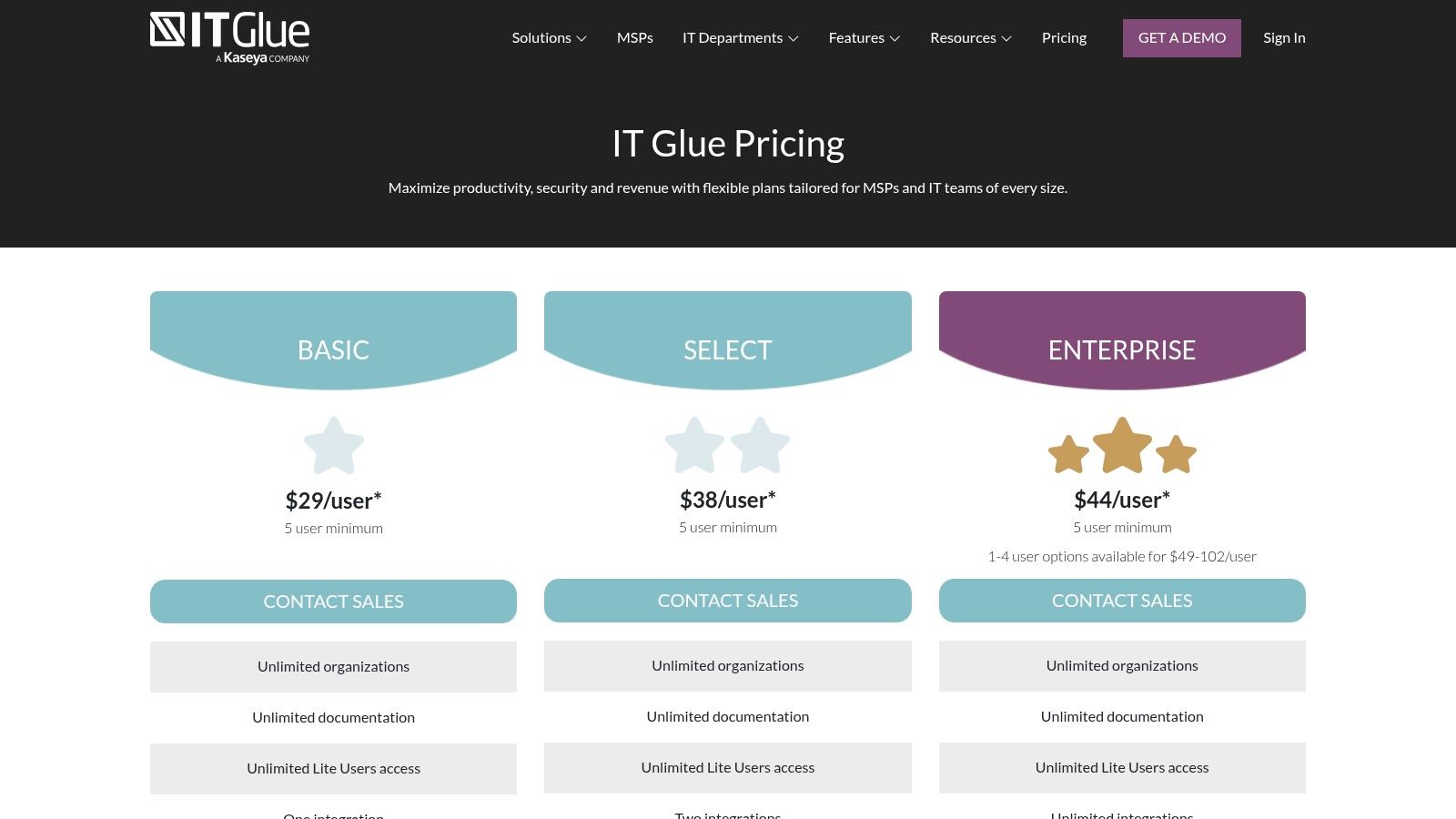
Its strength lies in its deep integration with PSA and RMM tools, which automatically populates and updates network device information, reducing manual entry. This creates a single source of truth that is always current. While its powerful features and compliance-ready audit trails are a major draw, the platform's pricing structure is a key consideration. IT Glue requires a per-user subscription with a five-user minimum on most plans, often coupled with a mandatory onboarding fee and a 36-month contract for the best pricing.
Key Features & Considerations
- Best For: MSPs and IT teams managing complex or multiple networks who need a centralized, automated documentation system.
- Unique Offering: Features like an AI-powered SOP generator and exportable runbooks provide ready-made documentation that goes beyond static templates.
- Pricing: Per-user model with a 5-user minimum. Be prepared for a significant upfront investment and long-term commitment.
Website: https://www.itglue.com/pricing/
2. Hudu
Hudu is a modern, streamlined IT documentation platform that serves both MSPs and internal IT teams. It provides a highly flexible alternative to legacy systems by offering customizable "Asset Layouts" that function as powerful, reusable network documentation templates. These layouts allow teams to standardize how they document everything from network gear and VLANs to ISP circuits and vendor contacts, ensuring consistency and completeness.
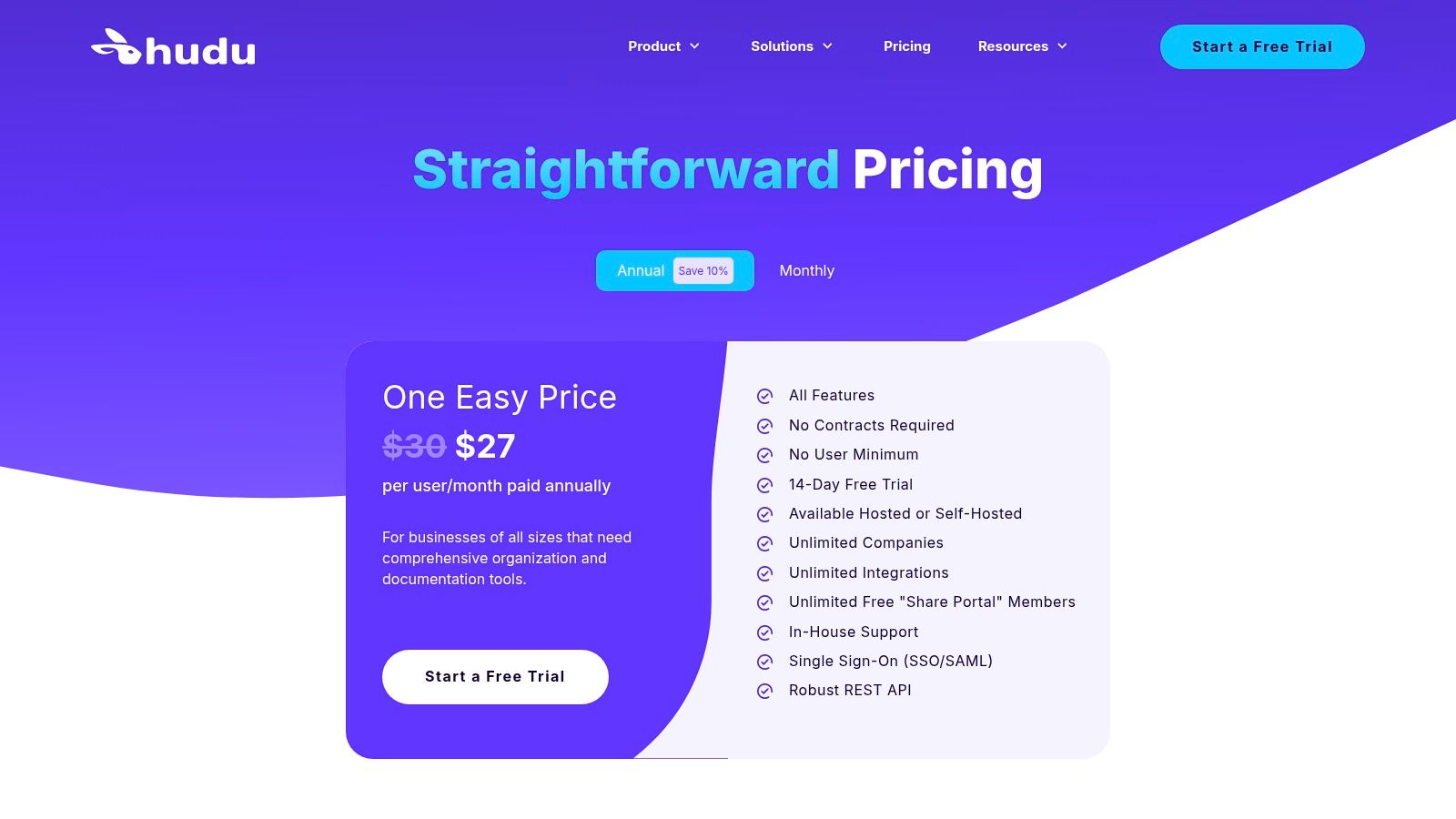
Its key differentiator is a simplified, value-focused approach with no user minimums and the option for either a cloud-hosted or self-hosted deployment at the same price. This flexibility makes it accessible for smaller teams and those requiring greater data control. While its integration ecosystem is still growing compared to more established competitors, its clean interface and straightforward templating system allow for rapid adoption. Hudu is an excellent choice for organizations prioritizing ease of use, cost-effectiveness, and deployment flexibility for their documentation needs.
Key Features & Considerations
- Best For: Small-to-mid-sized MSPs and IT departments seeking a modern, flexible documentation tool without high user minimums or long-term contracts.
- Unique Offering: The choice between a fully managed cloud version or a self-hosted option for the same price point, giving teams total control over their data environment.
- Pricing: A simple per-user, per-month model with no user minimums. Advanced features like a self-service portal are included in the base price.
Website: https://hudu.com/pricing/
3. Auvik
Auvik is an automated network discovery and management platform that excels at generating real-time documentation. Instead of providing static downloadable files, Auvik continuously scans the network to create and update crucial documents like topology maps and device inventories. This approach ensures that the information is always current, making its exportable assets some of the most accurate network documentation templates available, as they reflect the network's live state.
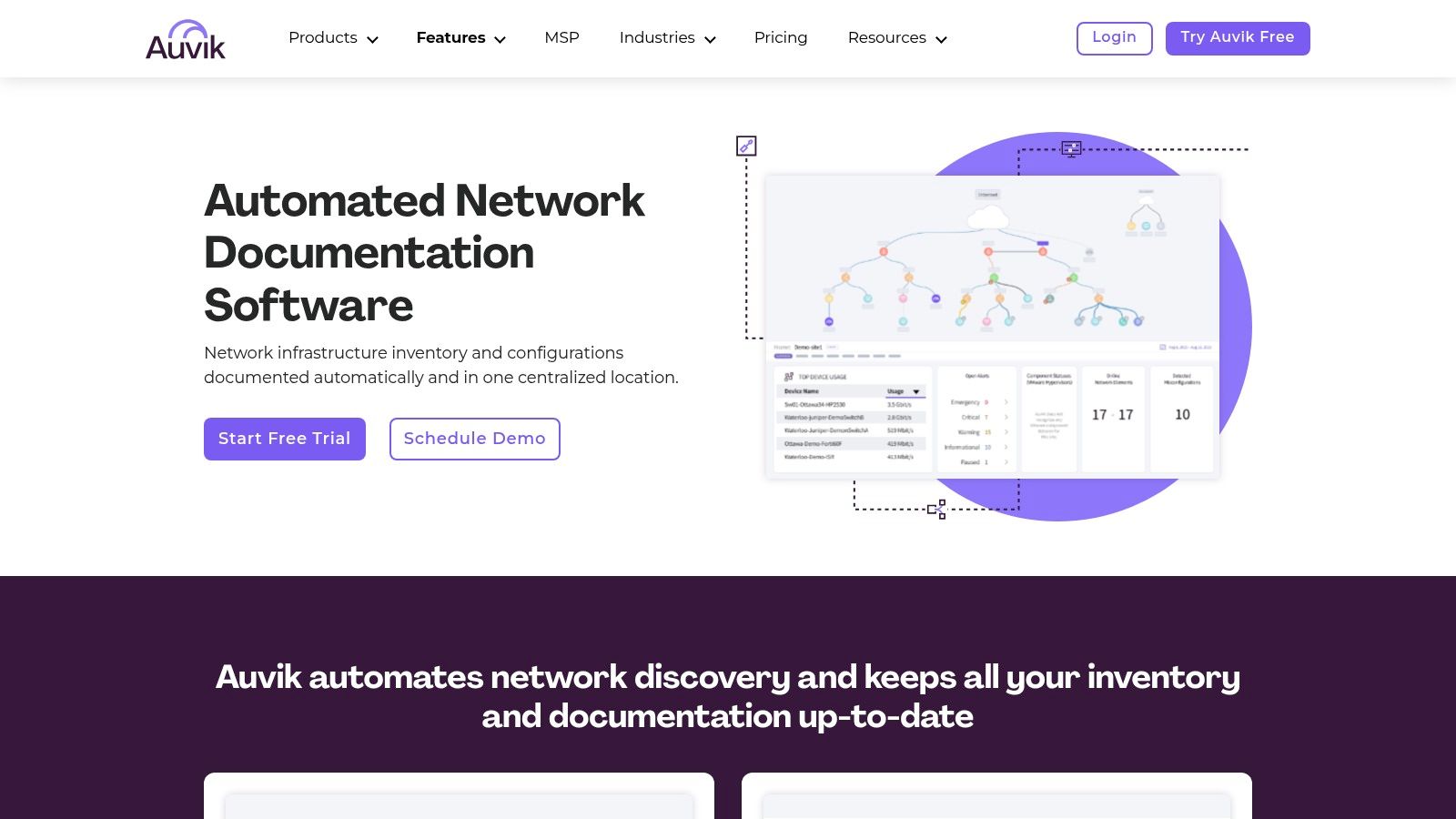
The platform's strength is its ability to minimize manual effort by automatically mapping network connections and backing up device configurations. This creates a powerful foundation for documentation that can be exported for compliance or planning. As one of the best network monitoring software solutions, Auvik is a powerful tool. However, its device-based pricing model can become expensive for large or rapidly growing environments. The platform is less suited for teams that only require a one-time static template rather than a dynamic, ongoing documentation and monitoring solution. Auvik offers a generous 14-day free trial to test its capabilities.
Key Features & Considerations
- Best For: MSPs and IT departments that need live, automated network visibility and documentation that stays constantly up-to-date.
- Unique Offering: Real-time, exportable topology maps and inventory lists that eliminate the divergence between documentation and the actual network state.
- Pricing: Per-device or per-site pricing model. Costs can scale quickly with the number of monitored devices on the network.
4. NetBox Labs (NetBox Cloud/Enterprise)
NetBox Labs provides a powerful, open-core platform that serves as a network source of truth, going far beyond basic network documentation templates. It offers a structured and opinionated data model for documenting your entire network, including IPAM (IP addresses, VLANs) and DCIM (racks, devices, circuits). Instead of static documents, NetBox creates a live, queryable database of your network's intended state, making it ideal for automation-driven environments.
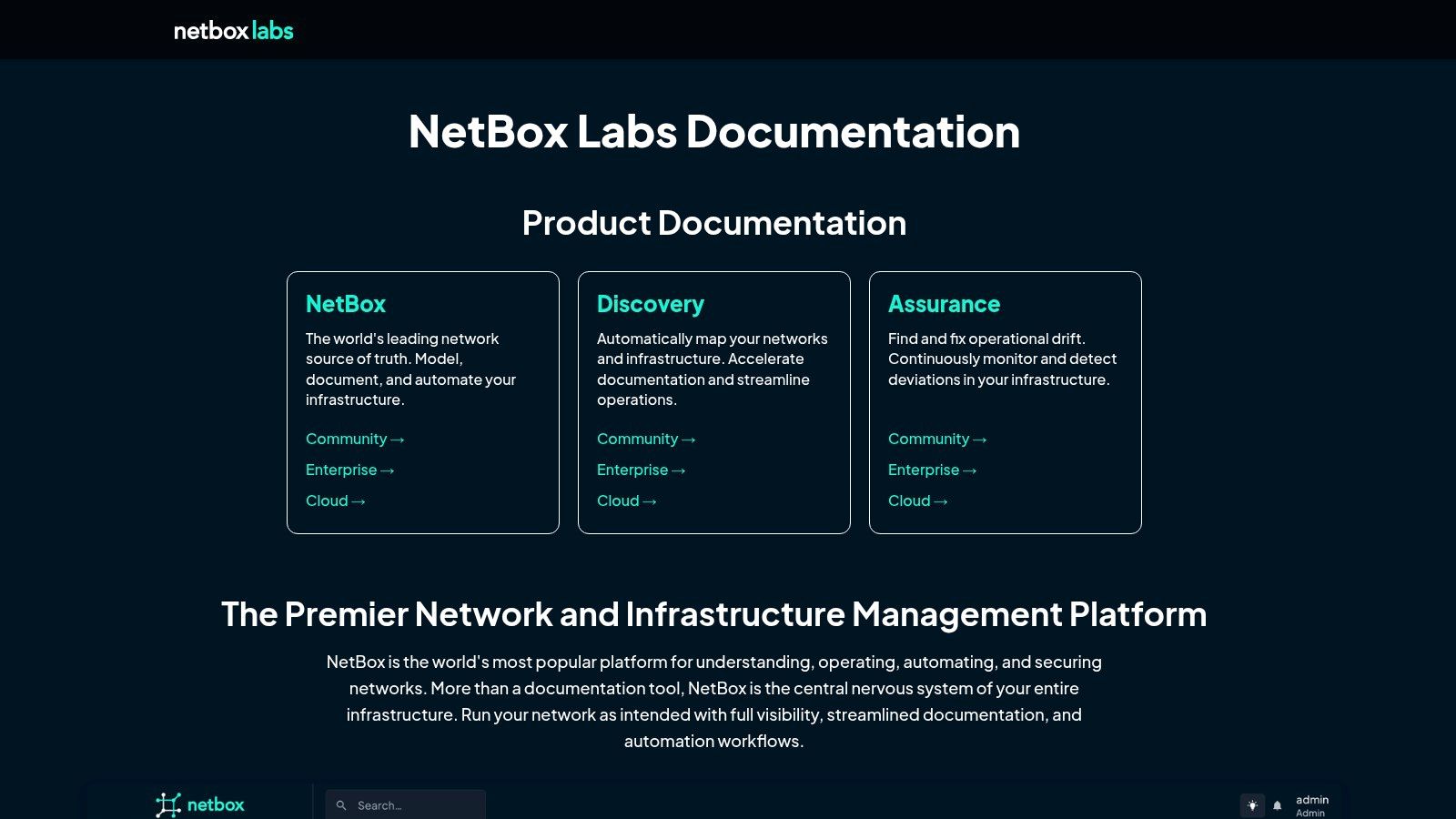
Its core strength lies in its API-first design, enabling deep integration with network automation tools to ensure documentation reflects the intended configuration. This approach helps teams understand what is network infrastructure as a programmable system. While the open-source version is self-hosted, NetBox Cloud offers a managed solution with advanced features like drift detection and discovery add-ons. The platform has a higher learning curve than simple spreadsheets but provides unparalleled structure and scalability.
Key Features & Considerations
- Best For: Network engineers and DevOps teams who need a definitive source of truth to drive network automation and ensure data integrity.
- Unique Offering: A robust, API-driven data model specifically designed for network infrastructure, which is a significant step up from general-purpose documentation tools.
- Pricing: A free, self-hosted open-source version is available. Paid cloud and enterprise plans offer managed services, support, and enhanced features, with pricing tailored to organizational needs.
Website: https://netboxlabs.com/docs?utm_source=openai
5. Microsoft Visio
Microsoft Visio is a long-standing, powerful diagramming tool and a staple in many enterprise environments for creating formal network documentation. Rather than being a full documentation platform, it focuses on delivering high-quality, detailed schematics. Visio offers a wide array of network documentation templates, from basic logical diagrams to intricate physical layouts, making it ideal for creating audit-ready, professional-grade visuals of network infrastructure.
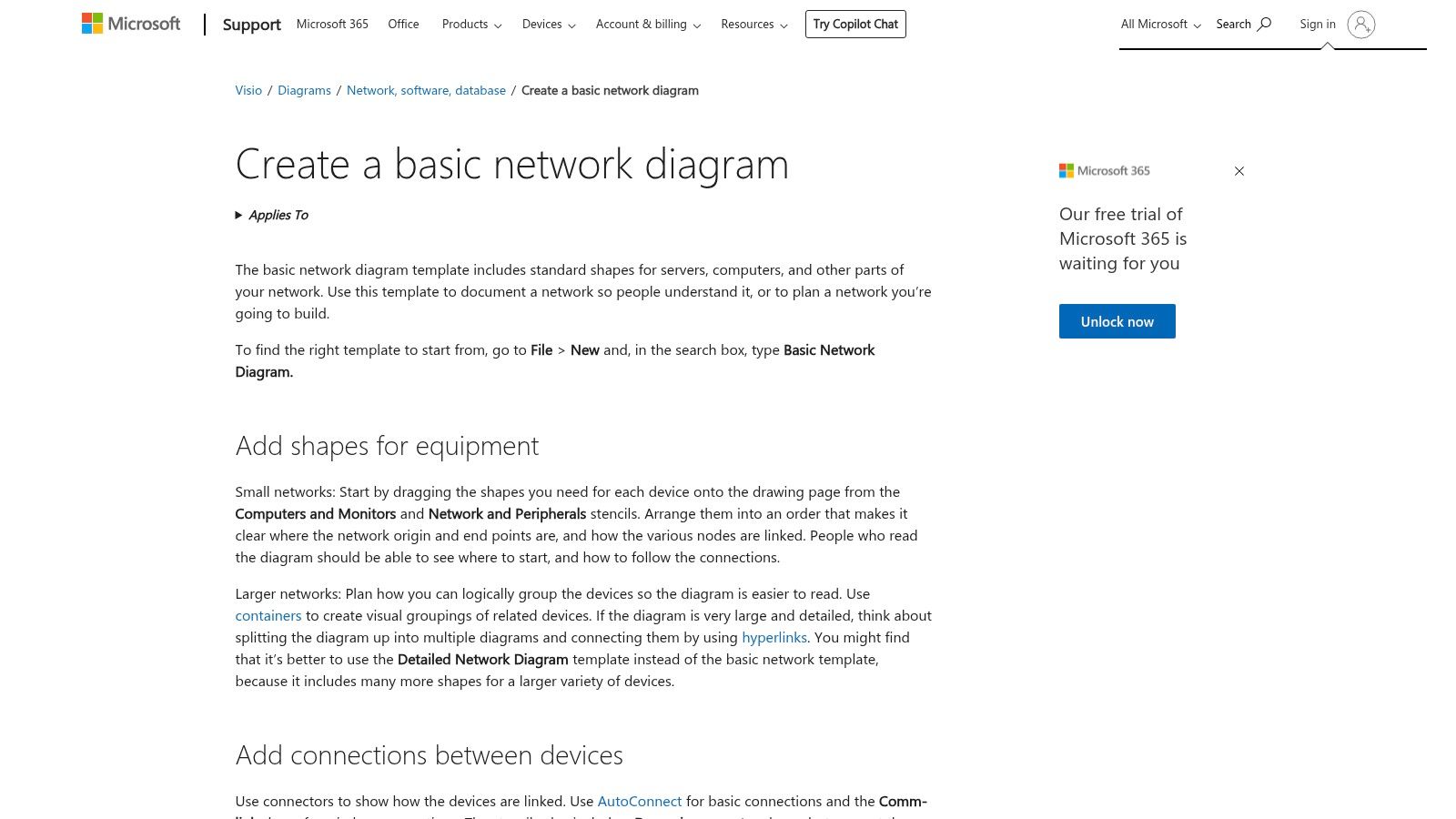
Its primary advantage is its ubiquity within the Microsoft 365 ecosystem, allowing for easier sharing and integration for organizations already invested in Microsoft products. The application includes extensive stencil libraries with standardized symbols for network components, including updated sets for cloud providers like Azure and AWS. While Visio is an industry standard, it operates on a subscription model, and real-time collaboration can feel less fluid than modern, web-native alternatives. Many of the most useful templates and stencils are only available with a paid plan.
Key Features & Considerations
- Best For: IT professionals and network engineers who need to create formal, detailed, and print-ready network diagrams for presentations, audits, or compliance.
- Unique Offering: Extensive and industry-standard stencil libraries, including specific icons for major cloud services (Azure, AWS), which are crucial for hybrid environment documentation.
- Pricing: Available through Visio Plan 1 (web-only) or Visio Plan 2 (desktop and web) subscriptions, often separate from standard Microsoft 365 licenses.
6. Lucid (Lucidchart/Lucidscale)
Lucid is a suite of cloud-based visual collaboration tools, with Lucidchart being its flagship diagramming application. It is an excellent resource for creating professional-grade network diagrams from a vast library of network documentation templates. The platform simplifies the process of visualizing complex network topologies, offering specific templates for LAN, WAN, wireless, security, and major cloud providers like AWS and Azure, making it highly versatile for various IT environments.
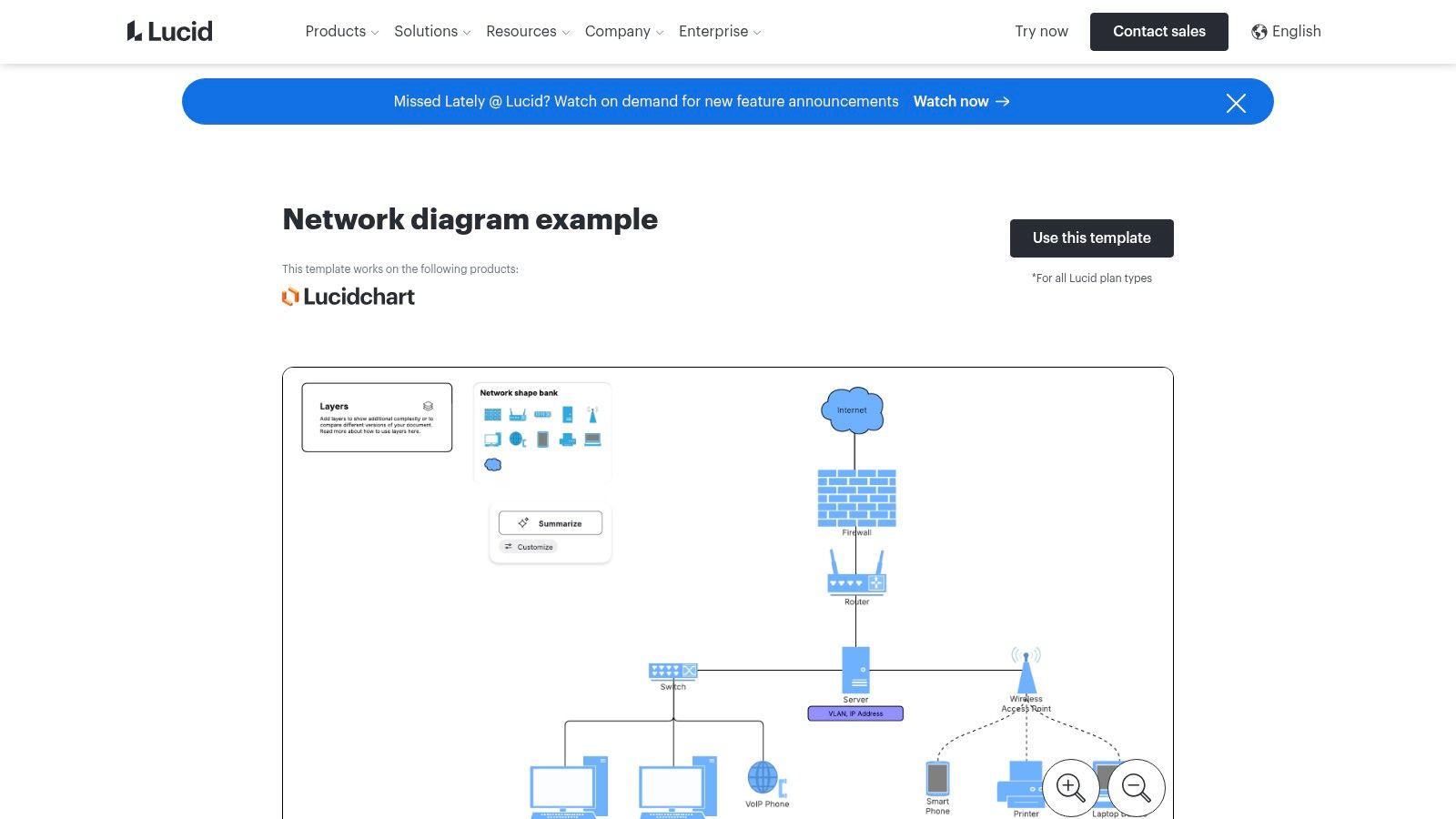
Its core strength is its intuitive, drag-and-drop interface and real-time collaboration features, allowing teams to build and refine diagrams together. While Lucidchart relies on manual creation, it can be paired with Lucidscale for automated cloud visualization. The platform operates on a freemium model; the free tier is great for simple diagrams, but access to advanced shape libraries, data linking, and larger documents requires a paid subscription, which is billed per user.
Key Features & Considerations
- Best For: Teams needing to quickly create polished, professional network diagrams for presentations, onboarding, or planning without a steep learning curve.
- Unique Offering: Extensive vendor-specific shape libraries (Cisco, AWS, Azure, GCP) and data-linking capabilities to create dynamic, data-driven diagrams.
- Pricing: Offers a limited free plan. Paid plans are subscription-based, starting per user, which can become costly for larger teams.
Website: https://lucid.co/templates/network-diagram-example?utm_source=openai
7. diagrams.net (draw.io)
diagrams.net, widely known as draw.io, is a free and highly versatile browser-based diagramming tool. It serves as an excellent resource for creating visual network documentation templates from scratch or by using its built-in gallery. Unlike subscription platforms, it offers a powerful, no-cost solution for crafting detailed network diagrams, flowcharts, and rack layouts, making professional-grade documentation accessible to everyone.
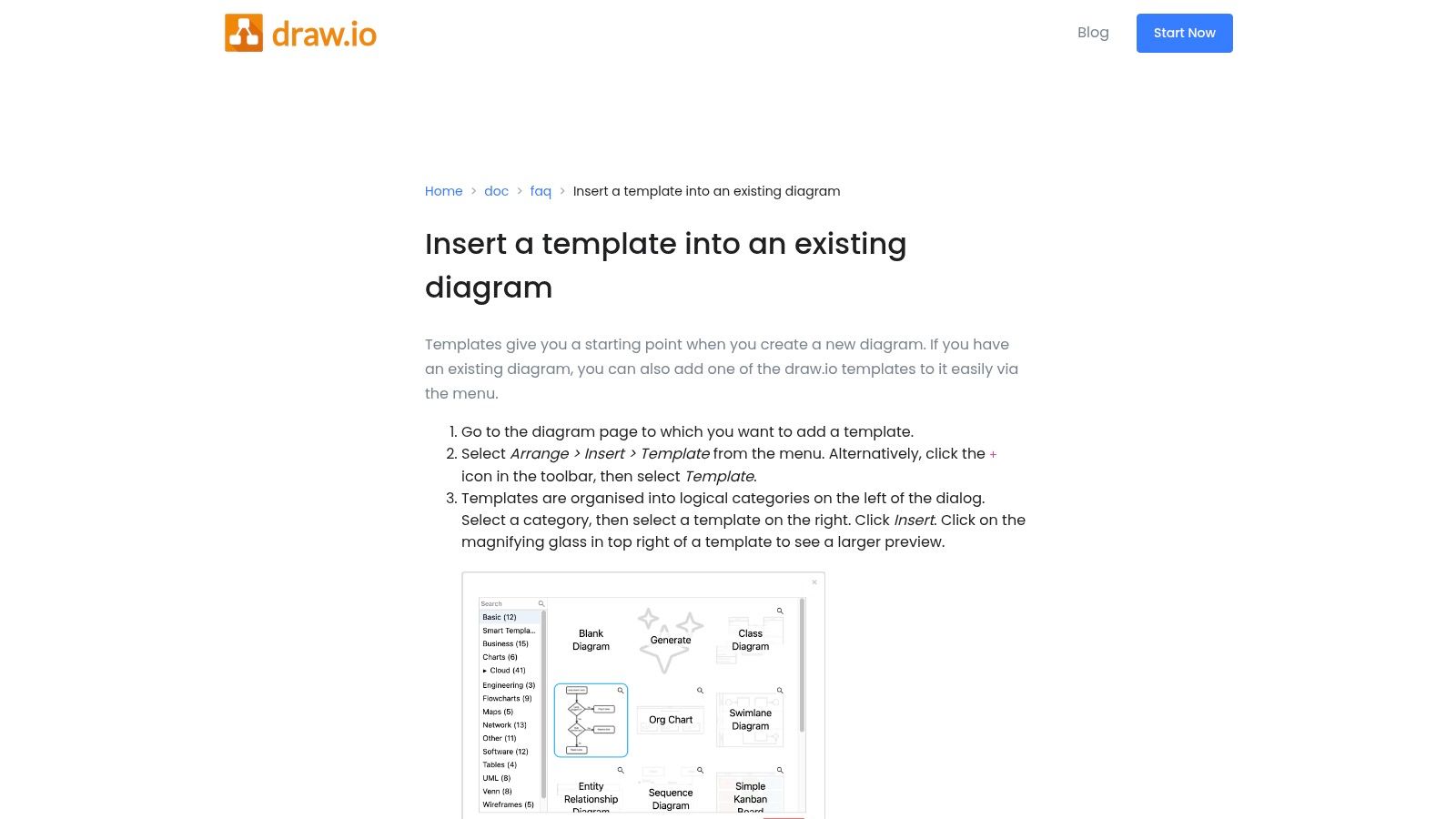
Its core strength is its flexibility and extensive library of vendor-specific shapes from brands like AWS, GCP, Azure, and Cisco, allowing for precise and accurate diagrams. The platform seamlessly integrates with Google Drive, OneDrive, and GitHub for collaborative editing and version control. While it lacks the automated data population of tools like IT Glue, its zero-cost barrier and offline desktop app make it an unbeatable choice for teams needing a powerful, manual diagramming tool without a budget.
Key Features & Considerations
- Best For: Individuals, small businesses, and IT teams who need a powerful, no-cost tool for creating custom visual network documentation.
- Unique Offering: It is completely free for web and desktop use without requiring sign-up, offering direct integration with cloud storage for real-time collaboration.
- Pricing: Free. Advanced enterprise features for document management are available through paid add-ons for Atlassian Confluence and Jira.
Website: https://www.drawio.com/doc/faq/insert-template?utm_source=openai
8. Miro
Miro is a highly collaborative online whiteboard platform that treats network documentation as a living, visual artifact rather than a static file. While not a dedicated IT documentation tool, it offers a rich library of network documentation templates, including specialized templates for Cisco, AWS, and Azure architectures. Its main purpose is to facilitate real-time, cross-functional teamwork, making it ideal for brainstorming sessions, network planning, and creating easily understandable diagrams for diverse stakeholders.
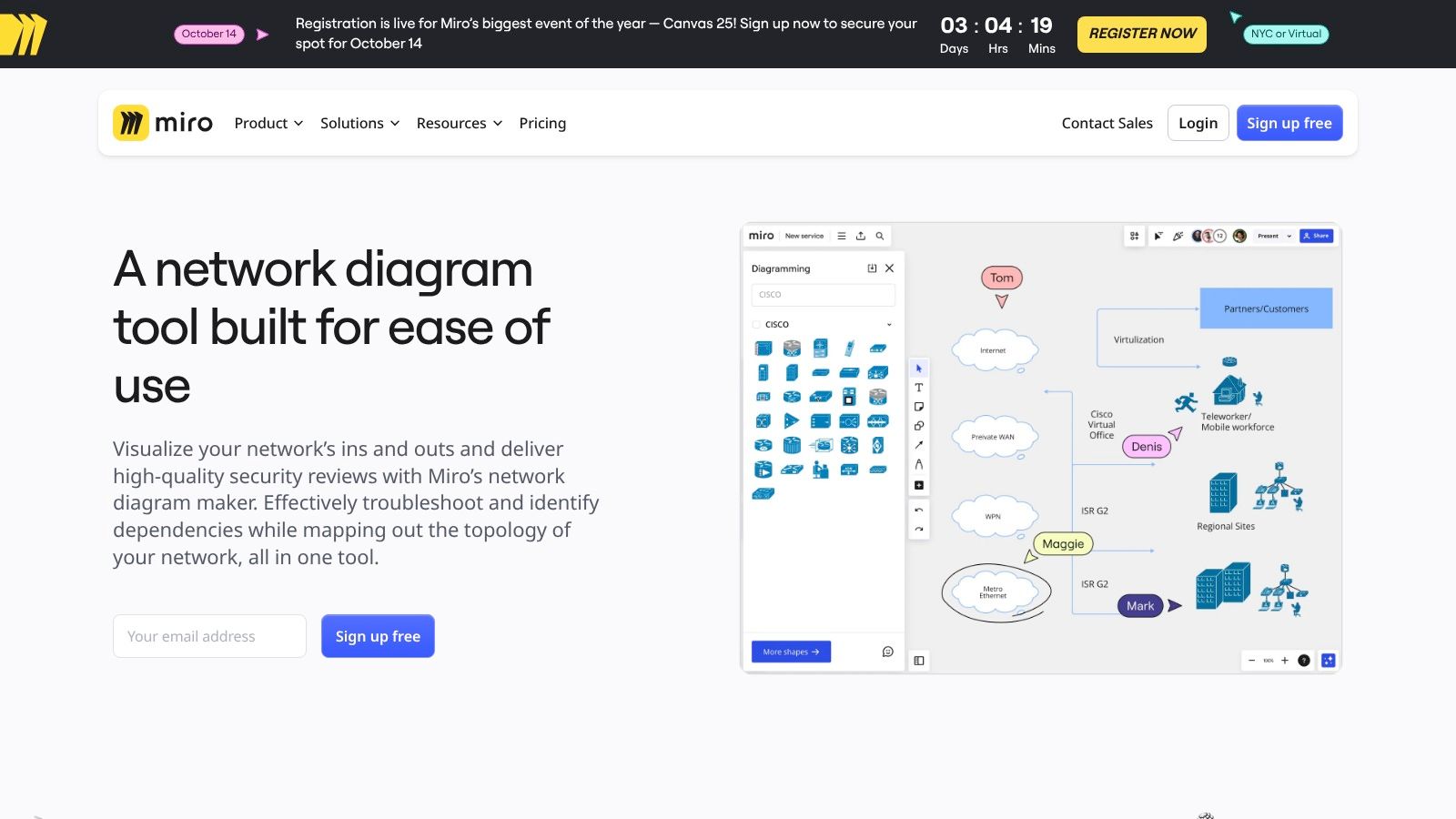
The platform's strength is its intuitive, drag-and-drop interface and vast icon libraries that allow teams to quickly map out network infrastructure. Unlike traditional documentation tools, Miro excels at turning a network diagram into an interactive workspace with comments, version history, and presentation modes. While it is excellent for collaborative design and high-level overviews, it may lack the precision and data-linking capabilities required for extremely detailed, large-scale network maps. Access to many advanced templates and features requires a paid subscription.
Key Features & Considerations
- Best For: Teams needing a collaborative, visual tool for network planning, design workshops, and creating high-level architectural diagrams.
- Unique Offering: The interactive whiteboard format makes network diagrams a shared, dynamic resource for simultaneous collaboration, ideal for hybrid teams.
- Pricing: Offers a limited free plan. Paid plans are billed per user, with more advanced templates and features reserved for these tiers.
Website: https://miro.com/diagramming/network-diagram/
9. Cacoo (Nulab)
Cacoo is a cloud-based diagramming tool that focuses on collaborative creation, making it a strong choice for teams needing to build visual network documentation templates. It provides a library of ready-to-use network and AWS architecture diagrams, allowing teams to get started quickly. The platform's core value is its real-time, multiuser editing and commenting features, which streamline the feedback and approval process for network designs.
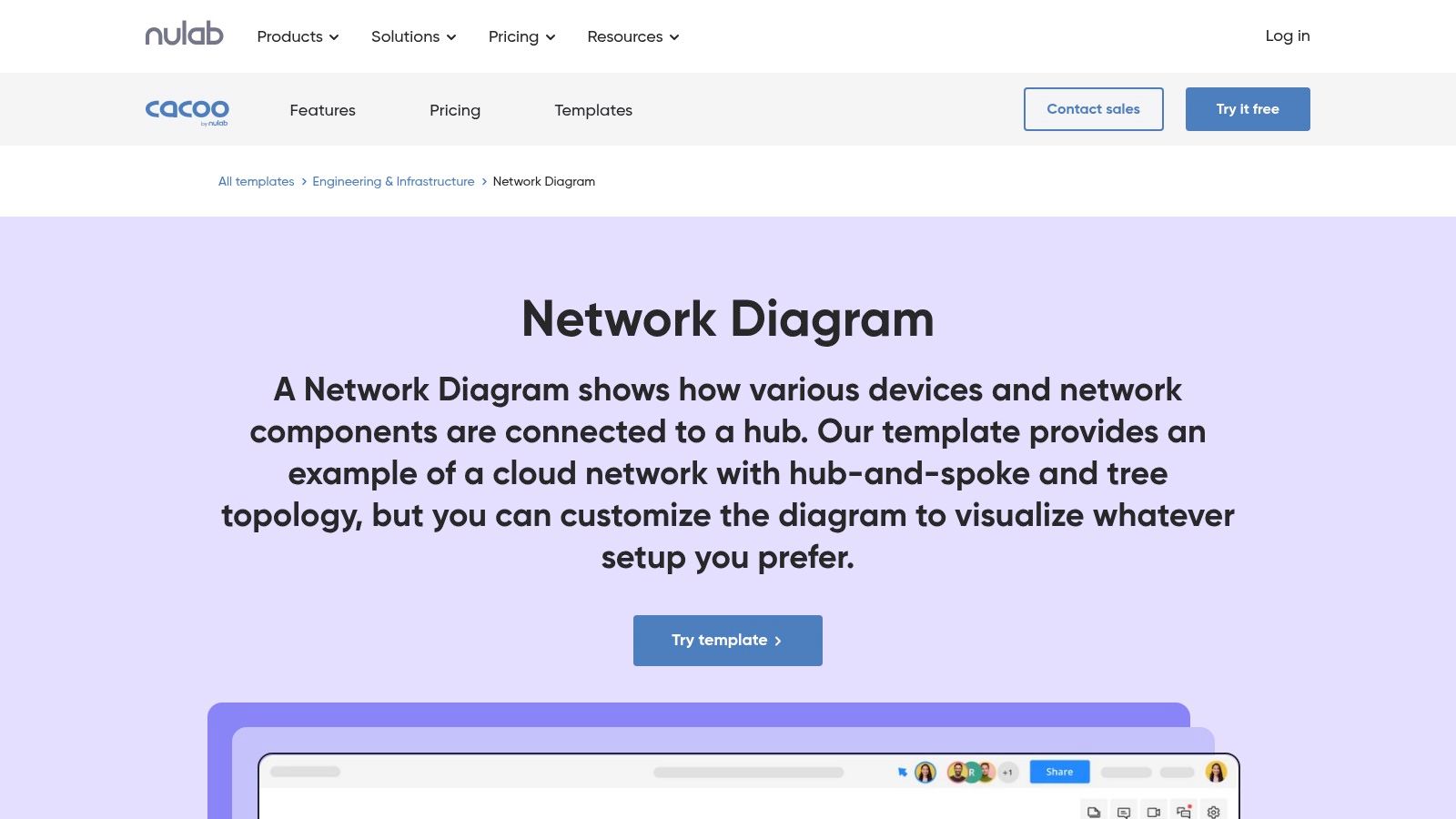
Unlike more complex platforms, Cacoo emphasizes ease of use and rapid template deployment. Its ability to create and share custom templates within a team ensures that all network diagrams adhere to a consistent standard. While its user base is smaller compared to giants like Lucidchart or Miro, its focused feature set is ideal for teams prioritizing collaborative diagramming over comprehensive IT asset management. Advanced features, such as enhanced security and admin controls, are reserved for its paid plans.
Key Features & Considerations
- Best For: Teams needing a simple, collaborative tool for creating and standardizing visual network diagrams, especially for cloud infrastructure like AWS.
- Unique Offering: The ability to publish and share custom templates across a team promotes standardization directly within the tool.
- Pricing: Offers a free plan for individuals. Paid plans are required for team features, starting with a per-user monthly subscription.
Website: https://nulab.com/cacoo/templates/network-diagram/
10. SmartDraw
SmartDraw is a professional diagramming software that offers a focused and powerful solution for creating visual network documentation templates. Unlike more general-purpose tools, it provides dedicated templates specifically for network diagrams and rack elevations, complete with extensive symbol libraries that can be embedded with data. This makes it an excellent choice for teams needing to produce consistent, detailed, and audit-ready network documentation quickly and efficiently.
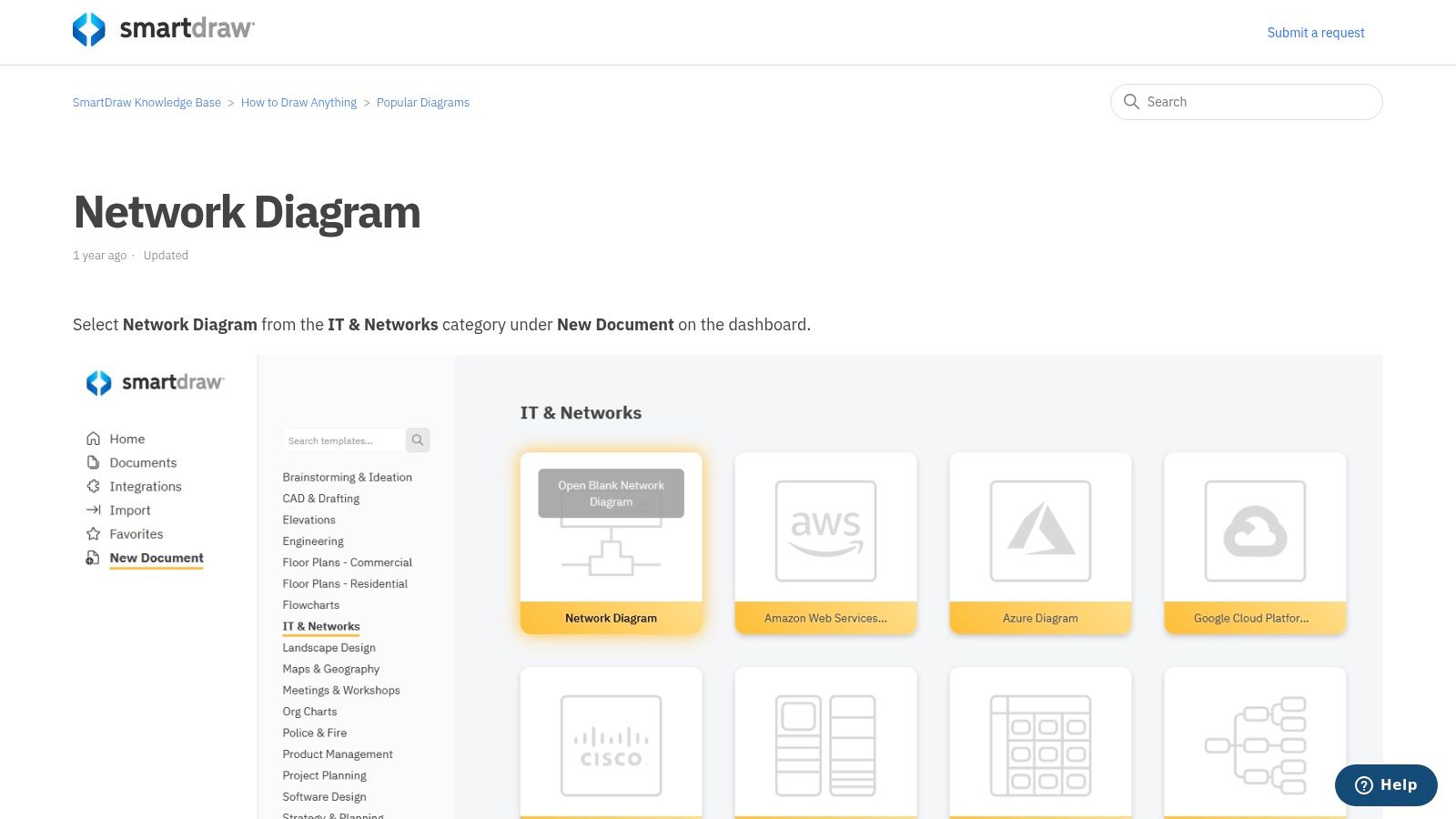
Its key advantage is the balance between ease of use and professional output, alongside strong integration capabilities. SmartDraw works seamlessly with Microsoft 365, Google Workspace, and Atlassian products, allowing diagrams to be embedded directly into existing workflows. For organizations transitioning away from Microsoft Visio, its robust import and export functionality provides a smooth migration path without losing historical data. The platform is a paid tool with a short trial, positioning it for serious professional use rather than casual diagramming.
Key Features & Considerations
- Best For: IT teams needing to create professional, data-rich network and rack diagrams who are migrating from or need an alternative to Visio.
- Unique Offering: Strong Visio import and export support makes it a top contender for teams looking to switch diagramming tools without starting from scratch.
- Pricing: Paid software with different tiers for individuals and teams; a short free trial is available to evaluate the features.
Website: https://smartdraw.zendesk.com/hc/en-us/articles/360042322612-Network-Diagram?utm_source=openai
11. TechRepublic Premium
TechRepublic Premium offers a variety of business-ready downloadable resources, including policy guides and checklists that serve as excellent foundational network documentation templates. It provides a structured starting point for IT teams looking to standardize their processes without building everything from scratch. The platform is particularly useful for those who need to establish formal policies alongside their technical documentation, bridging the gap between network administration and corporate governance.
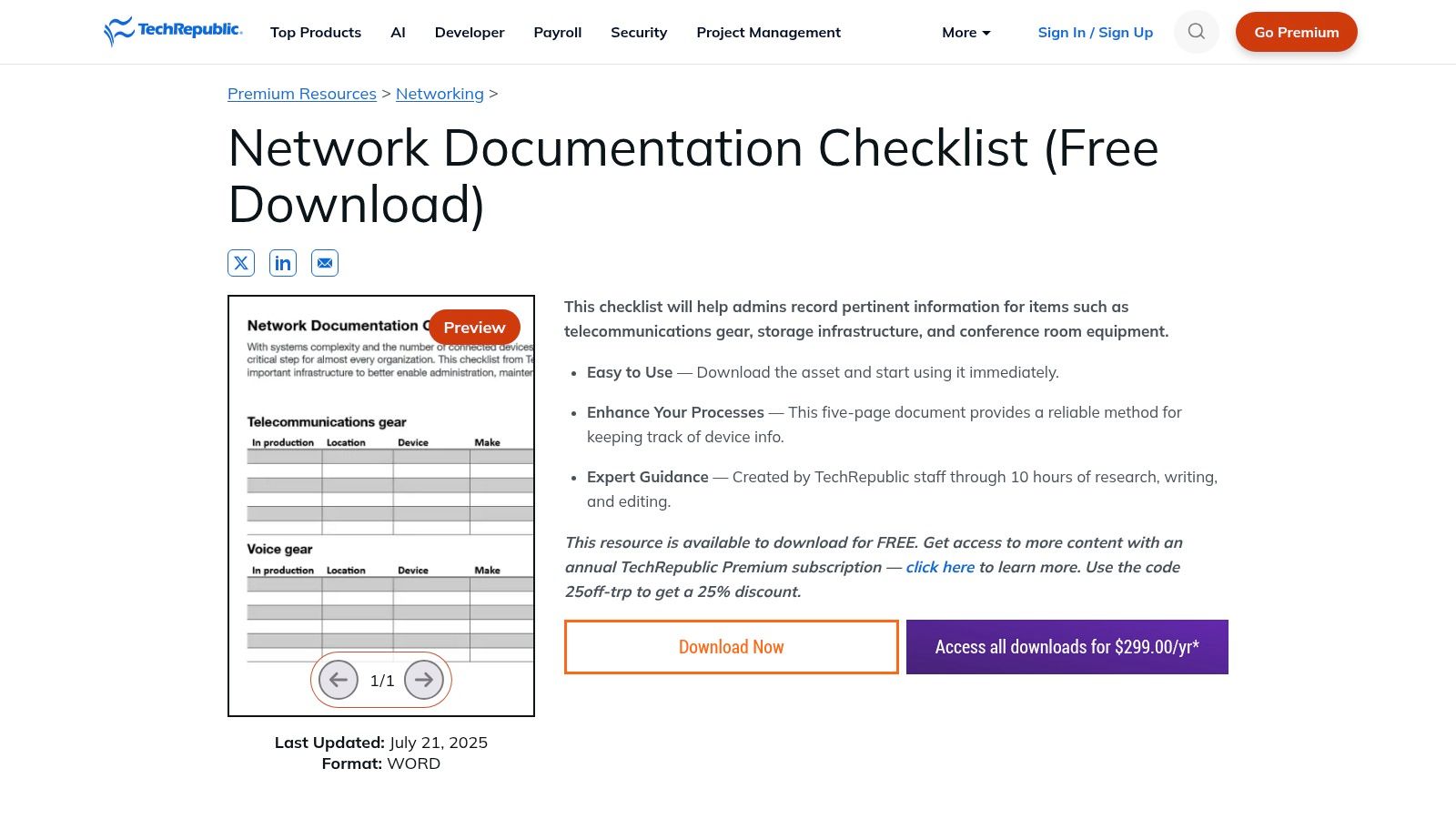
Its key offering for network managers is the Network Documentation Checklist, a comprehensive Word document that guides you through every component to catalog, from physical cabling to software licenses. This approach is less about dynamic asset management and more about providing a thorough, repeatable framework. While the checklist itself is often available as a free download, many of the more in-depth policy templates require a TechRepublic Premium subscription, making it a professional resource rather than a simple template repository.
Key Features & Considerations
- Best For: IT managers and system administrators who need structured checklists and policy documents to build or formalize their documentation standards.
- Unique Offering: Focuses on policy-level documents and comprehensive checklists, which complement visual diagramming tools like Visio or Lucidchart.
- Pricing: Some core resources like the checklist are free, but access to the full library of policies and templates requires a premium subscription.
12. ProProfs Knowledge Base (Network Documentation Template)
ProProfs Knowledge Base provides a free, structured template designed to function as an internal, web-based network guide. Instead of a simple downloadable file, it offers a ready-to-use framework within its knowledge base platform. This allows IT teams to quickly create, publish, and share comprehensive network documentation templates that are easily accessible via a web browser or mobile device, complete with customizable branding.
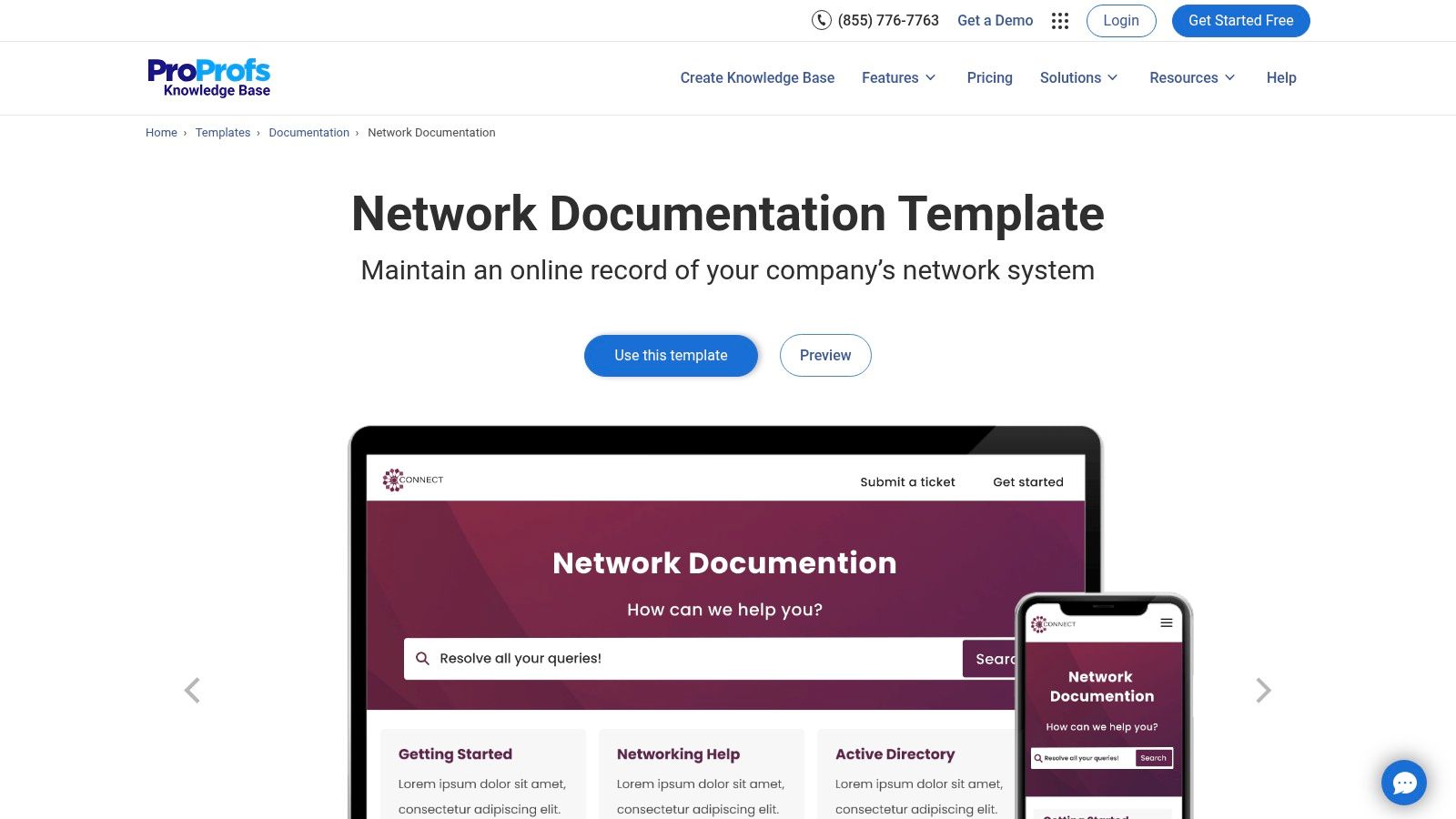
The platform's strength is its focus on narrative and procedural documentation. It excels at explaining the "why" and "how" behind the network setup, with a prebuilt table of contents and sections for everything from network topology to security policies. While its free template offers a great starting point, its best use is for text-based information paired with embedded diagrams from other tools. Advanced features like built-in workflows and detailed analytics require upgrading to a paid plan.
Key Features & Considerations
- Best For: Small to mid-sized teams needing a quick, low-cost way to publish a centralized, web-accessible network manual for internal use.
- Unique Offering: The ability to instantly publish the documentation as a branded, private knowledge base with a shareable link is a key differentiator. A more detailed exploration is available in our ProProfs Knowledge Base Network Documentation Template guide.
- Pricing: The core network template is free. Paid plans are required for advanced features like access control, integrations, and removing ProProfs branding.
Website: https://www.proprofskb.com/templates/network-documentation/?utm_source=openai
Network Documentation Templates Comparison
| Solution | Core Features ✨ | User Experience ★★★★☆ | Value Proposition 💰 | Target Audience 👥 | Unique Selling Points 🏆 | Price Points 💰 |
|---|---|---|---|---|---|---|
| IT Glue (Kaseya) | Asset templates, AI SOP generator, SSO, PSA/RMM integrations | Mature platform, robust compliance | Standardizes IT docs at scale | MSPs, IT teams | AI-powered runbooks, deep integrations | Per-user, 5-user min, onboarding fee |
| Hudu | Custom asset layouts, Share Portal, API, hosted/self-hosted parity | Simple rollout, flexible templating | No user minimum, cost-effective | MSPs, IT teams | Self-hosting option, no user minimum | Competitive, no min users |
| Auvik | Automated topology, configs backup, prebuilt alerts, multi-site | Real-time maps, reduces doc drift | Minimizes manual work | MSPs managing multi-sites | Automated network discovery and alerting | Device-based pricing, can be costly |
| NetBox Labs | IPAM/DCIM, APIs, plugins, auditing, drift detection | Best-practice data model, automation | Free cloud plan for small setups | Enterprises, automation-centric | Open-core source of truth, advanced auditing | Enterprise tier costly |
| Microsoft Visio | Network/cloud diagram templates, MS365 integration | Widely used, standard symbol libs | Formal, audit-ready diagrams | Enterprises, IT professionals | Extensive stencil libraries, MS Office integration | Paid plans required for some templates |
| Lucid (Lucidchart/Lucidscale) | Network templates, vendor libs, data import, collaboration | Polished diagrams, strong collaboration | Fast diagramming & sharing | Teams, consultants, MSPs | Cloud-based with real-time collaboration | Tiered paid plans |
| diagrams.net (draw.io) | Free web/desktop app, template manager, vendor libs, integrations | Free, customizable, extensible | No cost, broad integrations | All IT users, DIY professionals | Completely free, open access | Free |
| Miro | Network diagram boards, Cisco/AWS/Azure templates, collaboration | Excellent for teamwork, interactive docs | Supports living documentation | Cross-functional teams | Collaborative whiteboard with extensive icons | Freemium, paid for templates |
| Cacoo (Nulab) | Network/AWS templates, real-time multiuser editing, comments | Fast startup, template reuse | Team standardized docs | Small to mid-sized teams | Custom templates sharable across teams | Paid plans with pro features |
| SmartDraw | Network/Rack diagrams, extensive templates, Visio interoperability | Deep IT templates, Visio migration path | Audit-ready, professional output | IT teams migrating from Visio | Large template library, MS365 & Atlassian integrations | Paid software, short trial |
| TechRepublic Premium | Network Checklists, policy templates, Word format | Ready-to-use docs, practical guidance | Quick start with professional docs | IT managers, policy teams | Downloadable business-ready templates | Free & paid subscriptions |
| ProProfs Knowledge Base | Structured docs template, web/mobile publish, review workflows | Easy publishing, free starter templates | Centralized knowledge base | Organizations needing browsable docs | Free network doc templates, branding options | Free starter, paid Pro plans |
Choosing the Right Template for a Resilient Network
The journey through this extensive list of network documentation templates and platforms reveals a clear truth: there is no single best solution for every organization. Your ideal choice hinges on a careful assessment of your team's size, technical maturity, workflow, and budget. The right tool isn't just about creating documents; it's about building a living, breathing repository of network intelligence that empowers your team.
We've explored everything from comprehensive, multi-tenant platforms like IT Glue and Hudu, designed for the rigorous demands of MSPs and large IT departments, to powerful automated discovery tools like Auvik and NetBox Labs, which create a dynamic and accurate source of truth. For visual planning and collaborative design, platforms such as Lucidchart and Miro offer unmatched flexibility and intuitive interfaces. Meanwhile, resources from TechRepublic and ProProfs provide excellent starting points for smaller teams looking to establish foundational documentation practices without a significant initial investment.
Key Factors for Your Decision
As you move forward, consider these critical factors to guide your selection of the perfect network documentation templates or platform:
- Automation vs. Manual Entry: Do you need a system that automatically discovers and maps your network (like Auvik), or is your team prepared to maintain documentation manually using structured templates? Automated systems reduce human error but come at a higher cost.
- Collaboration and Accessibility: How will your team access and update information? Cloud-based platforms like Lucidchart and Miro excel at real-time collaboration, which is essential for distributed teams and project planning sessions.
- Integration Capabilities: Does the tool need to connect with your existing RMM, PSA, or other IT management software? Platforms like IT Glue and Hudu are built with deep integrations in mind, creating a unified operational dashboard.
- Scalability and Complexity: A simple Visio diagram may suffice for a small office, but a growing hospitality chain or multi-family property portfolio will require a scalable solution like NetBox to manage IP addresses, VLANs, and device configurations effectively.
Ultimately, the goal is to transform network documentation from a static, often-neglected task into a dynamic, central pillar of your IT operations. A well-documented network is the foundation for faster troubleshooting, seamless onboarding, strategic planning, and robust security. For property owners and managers in hospitality, senior living, or commercial real estate, this translates directly to enhanced guest satisfaction, operational efficiency, and a stronger bottom line. Adopting one of these solutions is a strategic investment in network resilience and operational excellence.
Overwhelmed by the complexity of network design, documentation, and 24/7 management? The experts at Clouddle Inc specialize in providing Network-as-a-Service (NaaS) solutions for hospitality and commercial properties, where meticulous documentation is integrated from day one. Let us build and manage a reliable, high-performance network for you, so you can focus on your business. Learn more about our managed network services at Clouddle Inc.


